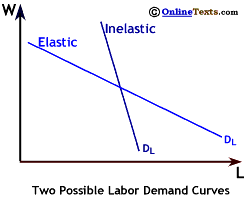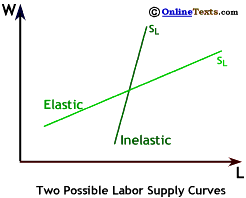 To the right we show two labor demand curves, one representing very elastic labor demand and the other representing very inelastic labor demand. Very elastic labor demand means that small changes in the wage rate lead to large changes in the number of workers hired. Factors that determine the elasticity of the demand for labor are similar to those that determine the elasticity of any other demand curve. Labor demand will be more elastic the easier it is to substitute capital (mechanical equipment, computers, etc.) for workers. The higher the percentage labor costs are of total costs, the more elastic labor demand will be because an increase in wage rates will have a large impact on overall production costs. The demand for labor is derived from the demand for the goods and services produced by labor, so the more elastic the demand is for the final product, the more elastic the demand for labor. Conversely, if labor is a small fraction of total costs, is difficult to replace with capital, and if product demand is inelastic, then labor demand will be inelastic.
To the right we show two labor demand curves, one representing very elastic labor demand and the other representing very inelastic labor demand. Very elastic labor demand means that small changes in the wage rate lead to large changes in the number of workers hired. Factors that determine the elasticity of the demand for labor are similar to those that determine the elasticity of any other demand curve. Labor demand will be more elastic the easier it is to substitute capital (mechanical equipment, computers, etc.) for workers. The higher the percentage labor costs are of total costs, the more elastic labor demand will be because an increase in wage rates will have a large impact on overall production costs. The demand for labor is derived from the demand for the goods and services produced by labor, so the more elastic the demand is for the final product, the more elastic the demand for labor. Conversely, if labor is a small fraction of total costs, is difficult to replace with capital, and if product demand is inelastic, then labor demand will be inelastic.

If labor supply is elastic, an increase in the wage rate draws many new people into the labor force who are not currently seeking employment. Students leave school, others leave part-time jobs seeking full-time employment, stay-at-home parents place children in day care to seek employment, and retirees return to the labor force, all in the hope of landing jobs at the higher wage. In addition, those in the labor force not having the skills needed to apply for jobs covered by the minimum wage can quickly acquire the necessary training. If labor supply is inelastic, the labor force participation rate (the percentage of the population who work or actively seek employment) is not very sensitive to changes in the wage rate and training for minimum wage jobs would not be needed, or if it is needed would be very costly or difficult to obtain. (If training is not needed, supply tends to be more inelastic because the number of workers who can compete for the jobs can't be easily increased by training, just as when training is very costly or difficult.)
Return to Minimum Wage Article